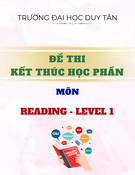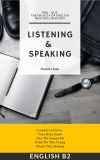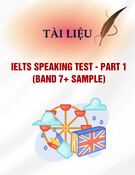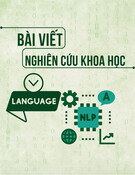
Tuyển tập Hội nghị Khoa học thường niên năm 2024. ISBN: 978-604-82-8175-5
577
USING PEER FEEDBACK IN WRITING CLASSROOMS
Nguyen Phuong Linh
Thuyloi University, email: linhnp@tlu.edu.vn
1. INTRODUCTION
Writing is often seen as a product, so the
traditional approach to teaching and learning
this important skill only focuses on two main
stages: the production of drafts by learners
and the summative assessment given by
teachers (Gaudiani, 1997; Lalande, 1982).
However, over the past few decades,
researchers and instructors have shifted to a
process-oriented approach to writing in
which learners produce multiple drafts and
receive feedback from the teacher, peers, or
even themselves (Flower & Hayes, 1981).
Peer feedback, also referred to as peer
review or peer assessment, is the act of
reading a classmate’s paper and helping the
mate improve it by asking questions and
leaving comments in both written and oral
form (Oshima & Hogue, 2007). Research
have compared the effectiveness of peer
feedback with teacher feedback and self-
feedback in improving students’ writing. The
results suggest each form of feedback serves
a different purpose in the writing classroom
(Chen, 2010; Lam; 2013; Ruegg, 2014;
Suzuki, 2018; Xu & Liu, 2010; Zhao, 2010;).
Therefore, multiple sources of feedback
should be integrated to maximize students’
improvement in writing (Birjandi & Tamjid,
2012). As a result, it is essential that teachers
understand how peer feedback can positively
affect students’ writing and have proper
strategies to effectively carry out this
approach in class.
2. RESEARCH METHODOLOGY
This secondary research focuses on
highlighting some impacts of peer feedback on
writing performance, motivation, and learner
autonomy. Then, recommendations on how to
effectively instruct and encourage students to
give useful feedback will be provided.
3. FINDINGS
3.1. Types of feedback
According to Nelson and Schunn (2009),
feedback can be summary statements,
problem/solution feedback, or praises.
Summary feedback focuses on the
discussed topics, the claims made or actions
taken by the author. Such statements let the
authors know how readers comprehend their
texts and use that understanding as a context
for other feedback. They also help
determine whether the actual performance
matched the intended performance (Nelson
& Schunn, 2009). This aligns with Ferris’s
findings (1997) that receiving summaries
about their writing encourage college
students to make more significant revisions.
Moreover, useful summaries can provide an
organizational framework by breaking down
information into more manageable parts
(Bransford et al., 2003).
Problem/solution feedback may be the
most common type of feedback (Hattie &
Timperly, 2007). It includes identification of
the problems, their locations, and suggestion
of solutions. Nelson and Schunn (2009)
discovered that authors were more likely to
understand and implement feedback if the
problems were explicitly identified and
located, and solutions were offered.
However, unclear explanation of the problem
can decrease the likelihood of feedback

Tuyển tập Hội nghị Khoa học thường niên năm 2024. ISBN: 978-604-82-8175-5
578
implementation (ibid). This result replicates
Tseng and Tsai (2006)’s findings, which
suggests that unclear explanation from peers
can hurt writing performance.
Praise can be complimentary comment or
highlight a positive aspect in the paper
(Nelson & Schunn, 2009). Although the
impact of praises on changing student’s
writing can be quite small (Ferris, 1997;
Kluger & DeNisi, 1996), this feedback type
can motivate writing and revision activities
(Kulhavy & Wager, 1993). Moreover, while
general praise can result in short-term boost of
motivation, praise that emphasizes the process
of a learner’s work tend to be more effective
over the long term (Mercer & Ryan, 2013).
3.2. The impacts of peer feedback on
writing performance, motivation, and
learners’ autonomy
Both feedback givers and receivers can
make significant improvements in their
writing performance. For those who give
feedback, this practice helps them develop
the ability to detect and solves problems
(Flower et al., 1986; Nicol et al., 2014;
Patchan & Schunn, 2015). Moreover, by
reviewing their peers’ papers, a learner can
be motivated to read his/her peers’ languages
more attentively and reflects upon how
he/she can make improvements in his/her
own writing (Alshuraidah & Storch, 2019).
For those who receive feedback, they can be
aware of the gap between their actual
performance and the desired performance,
then use the feedback to close this gap
(Hattie & Timperley, 2007; Nicol et al.,
2014). Another significant benefit of
exchanging feedback among peers is
encouraging learners to consider target
audiences (Nation, 2009). Understanding the
target audience can be extremely important
as it stimulates writers to choose suitable
linguistic and rhetorical resources to
successfully communicate a message.
Interestingly, despite the common
perception that only high-level learners can
provide or implement peer feedback, Yu and
Lee (2016) discovered that both low- and
high-level learners can effectively engage in
and benefit from feedback exchanging. In
fact, the lower-level group showed a more
significant improvement and admitted that
referring to peer comments for revision was
not a challenging task for them.
In terms of students’ engagement and
motivation, peer feedback has been proved to
have positive impacts as well. Firstly,
feedback from peer can increase a learner’s
self-efficacy. In a writing classroom, self-
efficacy refers to a learner’s belief that he/she
can produce a text that meet the desired
requirements (Bandura, 1986; Schunk &
Swartz, 1993). Since peer feedback can offer
solutions to reach the goal performance, it can
significantly enhance learners’ self-efficacy
(Duijnhouwer, Prins, & Stokking, 2012).
Secondly, peer feedback can motivate learners
to produce more well-written texts as learners
would want to impress their peers (Zhang et
al., 2014). This conclusion seems to be highly
relevant regarding the face-saving culture in
Asia, in which learners would try their best to
seek for praises from peer.
Lastly, integrating peer feedback into
writing classrooms can also increase learner
autonomy. According to Hyland (2000), by
actively deciding how to use a peer’s
comment, learners can take more
responsibility over their own writing. Shen,
Bai, and Xue (2020) suggested that
exchanging feedback allows learners to
assess their own learning process and
develop their own critical judging ability, as
teacher is no longer the sole evaluator. In this
way, peer feedback helps move the classroom
away from the traditional teacher-centered
approach and foster independent learning
(Hyland & Hyland, 2019). Another
noticeable impact of peer feedback on learner
autonomy is increasing confidence. The
process of reviewing and revising using
peers’ comments helps learners recognize
their potential to complete a task without

Tuyển tập Hội nghị Khoa học thường niên năm 2024. ISBN: 978-604-82-8175-5
579
depending too much on teacher support
(Shen, Bai, & Xue, 2020). Moreover, reading
other peers’ work can let student reviewers
know that other students face the same
challenges in writing as they do, which also
leads to a rise in writers’ confidence
(Chaudron, 1984).
3.3. Recommendations
Upon understanding the relationship
between peer feedback and students’ writing
performance, motivation and autonomy, it is
important that teachers know how to
effectively integrate this feedback approach
into their writing classrooms.
Firstly, peer feedback should be treated as
a regular activity in the writing classroom
rather than a one-time event (Lee, 2017).
Additionally, preliminary training is crucial
for successful implementation of peer
feedback in writing classroom. Levi
Altsteadter (2016) discovered that trained
students were more aware of global aspects
and can make more relevant and specific
comments than their untrained peers. During
training sessions, teachers should provide
worksheets as instructional guidelines, sample
essays and example of types of feedback.
Moreover, students would be more willing
to exchange feedback if they worked with
fixed partner and were allowed to use mother
tongue (Yu & Lee, 2016).
4. CONCLUSION
Integrating various types of peer feedback,
including summary, problem/solution, and
praise, into the writing classrooms is a
valuable strategy to support comprehensive
student development. This practice not only
enhances the quality of student writing but
also boosts their motivation and fosters a
sense of independence and confidence. To
maximize these benefits, it is recommended
that educators provide clear instructions and
structured guidance on how to effectively
give and receive peer feedback.
5. REFERENCES
[1] Nelson, M. M., & Schunn, C. D. (2009). The
nature of feedback: How different types of
peer feedback affect writing performance.
Instructional science, 37, 375-401.
[2] Yu, S., & Lee, I. (2016). Peer feedback in
second language writing (2005-2014).
Language Teaching, 49(4), 461-493.
[3] Duijnhouwer, H., Prins, F. J., & Stokking,
K. M. (2012). Feedback providing
improvement strategies and reflection on
feedback use: Effects on students’ writing
motivation, process, and performance.
Learning and Instruction, 22(3), 171-184.
[4] Hyland, F. (2000). ESL writers and feedback:
Giving more autonomy to students.
Language teaching research, 4(1), 33-54.
[5] Shen, B., Bai, B., & Xue, W. (2020). The
effects of peer assessment on learner
autonomy: An empirical study in a Chinese
college English writing class. Studies in
Educational Evaluation, 64, 100821.
[6] Zhang, H., Song, W., Shen, S., & Huang, R.
(2014). The effects of blog-mediated peer
feedback on learners’ motivation,
collaboration, and course satisfaction in a
second language writing course.
Australasian Journal of Educational
Technology, 30(6).



![Mẫu câu viết thư thân mật bằng Tiếng Anh [Chuẩn Nhất]](https://cdn.tailieu.vn/images/document/thumbnail/2025/20250708/caotiendat91211.thd2017@gmail.com/135x160/80151751961845.jpg)
![Tài liệu gợi ý viết email tiếng Anh và 35 đề thi mẫu [chuẩn SEO]](https://cdn.tailieu.vn/images/document/thumbnail/2025/20250708/caotiendat91211.thd2017@gmail.com/135x160/25321751961846.jpg)







![Đề cương môn Tiếng Anh 1 [Chuẩn Nhất/Mới Nhất]](https://cdn.tailieu.vn/images/document/thumbnail/2025/20251130/cubabep141@gmail.com/135x160/51711764555685.jpg)










![Mẫu thư Tiếng Anh: Tài liệu [Mô tả chi tiết hơn về loại tài liệu hoặc mục đích sử dụng]](https://cdn.tailieu.vn/images/document/thumbnail/2025/20250814/vinhsannguyenphuc@gmail.com/135x160/71321755225259.jpg)


